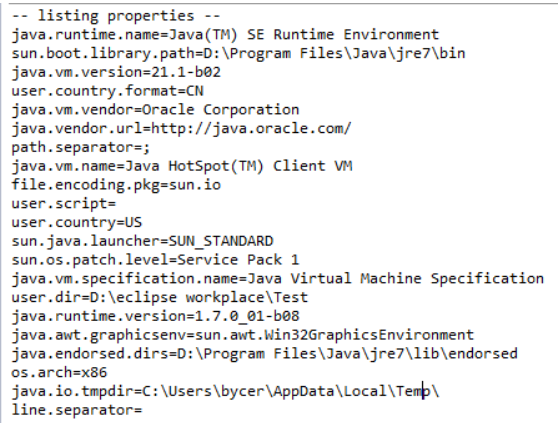Properties读取properties文件
今天就先从网上摘写总结下这个基础类,后续再加上实战总结补充进来,所以排版可能比较乱。。
在编写一个项目时,我们会时常修改一些配置变量来适应不同的运行环境,同时也让用户能够脱离程序去修改相关的变量设置。通常我们将这些变量定义在后缀名为properties的文件中,文件内容的格式为“键=值”,文本用“#”注释。
而java提供了java.util.Properties来读取这些文件,它提供了几个主要的方法:
- getProperty ( String key),用指定的键在此属性列表中搜索属性。也就是通过参数 key ,得到 key 所对应的 value。
- load ( InputStream inStream),从输入流中读取属性列表(键和元素对)。通过对指定的文件(比如说上面的 test.properties 文件)进行装载来获取该文件中的所有键 - 值对。以供 getProperty ( String key) 来搜索。
- setProperty ( String key, String value) ,调用 Hashtable 的方法 put 。他通过调用基类的put方法来设置 键 - 值对。
- store ( OutputStream out, String comments),以适合使用 load 方法加载到 Properties 表中的格式,将此 Properties 表中的属性列表(键和元素对)写入输出流。与 load 方法相反,该方法将键 - 值对写入到指定的文件中去。
- clear (),清除所有装载的 键 - 值对。该方法在基类中提供。
jdbc.properties:
driverClass = com.mysql.jdbc.Driver jdbcURL=jdbc:mysql://127.0.0.1:3306/protest?useUnicode=true&characterEncoding=utf-8 user = root password = root
使用FileInputStream("资源名称绝对路径")
public Properties propertiesFromFile() throws FileNotFoundException{ properties = new Properties(); InputStream in = null; try{ in = new BufferedInputStream(new FileInputStream(propertiesPath)); properties.load(in); }catch (FileNotFoundException e){ e.printStackTrace(); } catch (IOException e) { e.printStackTrace(); }finally{ try { in.close(); } catch (IOException e) { e.printStackTrace(); } } return properties; }
使用getClass.getResourceAsStream("资源名称") -推荐
public Properties propertiesFromClass(){ properties = new Properties(); InputStream in1 = this.getClass().getResourceAsStream(propertiesPath); InputStream is=PropertiesLoad.class.getResourceAsStream("/jdbc.properties"); try { properties.load(in1); } catch (IOException e) { e.printStackTrace(); }finally{ try { in1.close(); } catch (IOException e) { e.printStackTrace(); } } return properties; }
最后使用getProperty(key)获取properties中的值:
PropertiesLoad proLoad = new PropertiesLoad(propertiesPath); String DriverClass = proLoad.propertiesFromClass().getProperty("driverClass");
对于在程序中对properties文件的修改:
PropertiesLoad proLoad = new PropertiesLoad(propertiesPath); Properties pro = proLoad.propertiesFromClass(); OutputStream out = new FileOutputStream(DBconnect.class.getResource("/jdbc1.properties").toString().substring(6)); pro.setProperty("password", password+"1"); try { pro.store(out, "ceshiwenjian01"); } catch (IOException e) { e.printStackTrace(); }
#ceshiwenjian01 #Tue Aug 30 16:06:07 GMT+08:00 2016 driverClass=com.mysql.jdbc.Driver user=root password=root1 jdbcURL=jdbc\:mysql\://127.0.0.1\:3306/protest?useUnicode\=true&characterEncoding\=utf-8
在上述的例子中,如果将Properties pro = proLoad.propertiesFromClass();换成Properties pro = new Properties();那么最后jdbc1.properties中的键值对只剩下password。所以所谓的setProperties(key,value)是将键值对写放入pro中,然后pro通过store将所有的pro里的键值对写入到文件中。上例中最后呈现的结果类似于改变键值对的值是因为pro装载了原来的键值对。
我们知道,Java虚拟机(JVM)有自己的系统配置文件(system.properties),我们可以通过下面的方式来获取。
相关实例
1、获取JVM的系统属性
import java.util.Properties; public class ReadJVM { public static void main(String[] args) { Properties pps = System.getProperties(); pps.list(System.out); } }
结果:

2、一个比较综合的实例
//关于Properties类常用的操作 public class TestProperties { //根据Key读取Value public static String GetValueByKey(String filePath, String key) { Properties pps = new Properties(); try { InputStream in = new BufferedInputStream (new FileInputStream(filePath)); pps.load(in); String value = pps.getProperty(key); System.out.println(key + " = " + value); return value; }catch (IOException e) { e.printStackTrace(); return null; } } //读取Properties的全部信息 public static void GetAllProperties(String filePath) throws IOException { Properties pps = new Properties(); InputStream in = new BufferedInputStream(new FileInputStream(filePath)); pps.load(in); Enumeration en = pps.propertyNames(); //得到配置文件的名字 while(en.hasMoreElements()) { String strKey = (String) en.nextElement(); String strValue = pps.getProperty(strKey); System.out.println(strKey + "=" + strValue); } } //写入Properties信息 public static void WriteProperties (String filePath, String pKey, String pValue) throws IOException { Properties pps = new Properties(); InputStream in = new FileInputStream(filePath); //从输入流中读取属性列表(键和元素对) pps.load(in); //调用 Hashtable 的方法 put。使用 getProperty 方法提供并行性。 //强制要求为属性的键和值使用字符串。返回值是 Hashtable 调用 put 的结果。 OutputStream out = new FileOutputStream(filePath); pps.setProperty(pKey, pValue); //以适合使用 load 方法加载到 Properties 表中的格式, //将此 Properties 表中的属性列表(键和元素对)写入输出流 pps.store(out, "Update " + pKey + " name"); } public static void main(String [] args) throws IOException{ //String value = GetValueByKey("Test.properties", "name"); //System.out.println(value); //GetAllProperties("Test.properties"); WriteProperties("Test.properties","long", "212"); } }
结果:
Test.properties中文件的数据为:
#Update long name
#Sun Feb 23 18:17:16 CST 2014
name=JJ
Weight=4444
long=212
Height=3333
3、附例
name=root
pass=liu
key=value
读取a.properties属性列表,与生成属性文件b.properties。代码如下:
import java.io.BufferedInputStream; import java.io.FileInputStream; import java.io.FileOutputStream; import java.io.InputStream; import java.util.Iterator; import java.util.Properties; public class PropertyTest { public static void main(String[] args) { Properties prop = new Properties(); try{ //读取属性文件a.properties InputStream in = new BufferedInputStream (new FileInputStream("a.properties")); prop.load(in); ///加载属性列表 Iterator<String> it=prop.stringPropertyNames().iterator(); while(it.hasNext()){ String key=it.next(); System.out.println(key+":"+prop.getProperty(key)); } in.close(); ///保存属性到b.properties文件 FileOutputStream oFile = new FileOutputStream("b.properties", true);//true表示追加打开 prop.setProperty("phone", "10086"); prop.store(oFile, "The New properties file"); oFile.close(); } catch(Exception e){ System.out.println(e); } } }
项目中读取资源配置文件的方法
项目结构如图,ReadProperties.java为读取资源文件主要方法:

前提:使用 InputStream 进行读取时,需注意关闭流!!
相同代码部分:
Properties prop=new Properties(); InputStream ins=null; try{ ins....... // 代码变更部分 prop.load(ins); String resultStr=prop.getProperty("param1"); }catch(Exception e){ e.printStackTrace(); }finally{ if(null!=ins){ try{ ins.close(); }catch(IOException e){ e.printStackTrace(); } } }
代码变更部分:
1、读取myPro1.properties,读取和类文件同一目录下的资源文件:
ins=ReadProperties.class.getResourceAsStream("myPro1.properties");// 不用 getClassLoader() 来获取getResourceAsStream(),这是获取同一路径下的资源文件
2、读取myPro2.properties,读取另一文件夹下的资源文件:
ins=ReadProperties.class.getClassLoader().getResourceAsStream("config/myPro2.properties");// 写资源文件所在的路径
3、读取myPro3.properties,读取src根目录下的资源文件:
ins=ReadProperties.class.getClassLoader().getResourceAsStream("myPro3.properties");// 只写资源文件名称即可
4、读取myPro4.properties,读取另一资源包下的资源文件
ins=ReadProperties.class.getClassLoader().getResourceAsStream("myPro4.properties");// 只写文件名即可;如果是configFolder/myPro4.properties,则报null异常
5、读取myPro5.properties,读取另一包下的资源文件
ins=ReadProperties.class.getClassLoader().getResourceAsStream("com/test/myPro5.properties"); // 资源文件所在路径,如果只写资源文件名称,报null异常
总结:
1、获取和类文件处于相同路径下的资源文件使用 ReadProperties.class.getResourceAsStream("myPro1.properties")来获取,不用.class.getClassLoader()
2、获取其它包或不同包下的文件夹下的配置文件,使用ReadProperties.class.getClassLoader().getResourceAsStream("config/myPro2.properties")来获取,参数是该资源文件所在的相对路径
3、获取src根目录或另一资源文件夹的根目录下的资源文件,使用ReadProperties.class.getClassLoader().getResourceAsStream("myPro2.properties") 参数只写资源文件名称即可。
文章整理自:
https://blog.csdn.net/l18848956739/article/details/79518911
https://www.cnblogs.com/changzhichen/p/5099880.html
https://www.cnblogs.com/bakari/p/3562244.html


 浙公网安备 33010602011771号
浙公网安备 33010602011771号